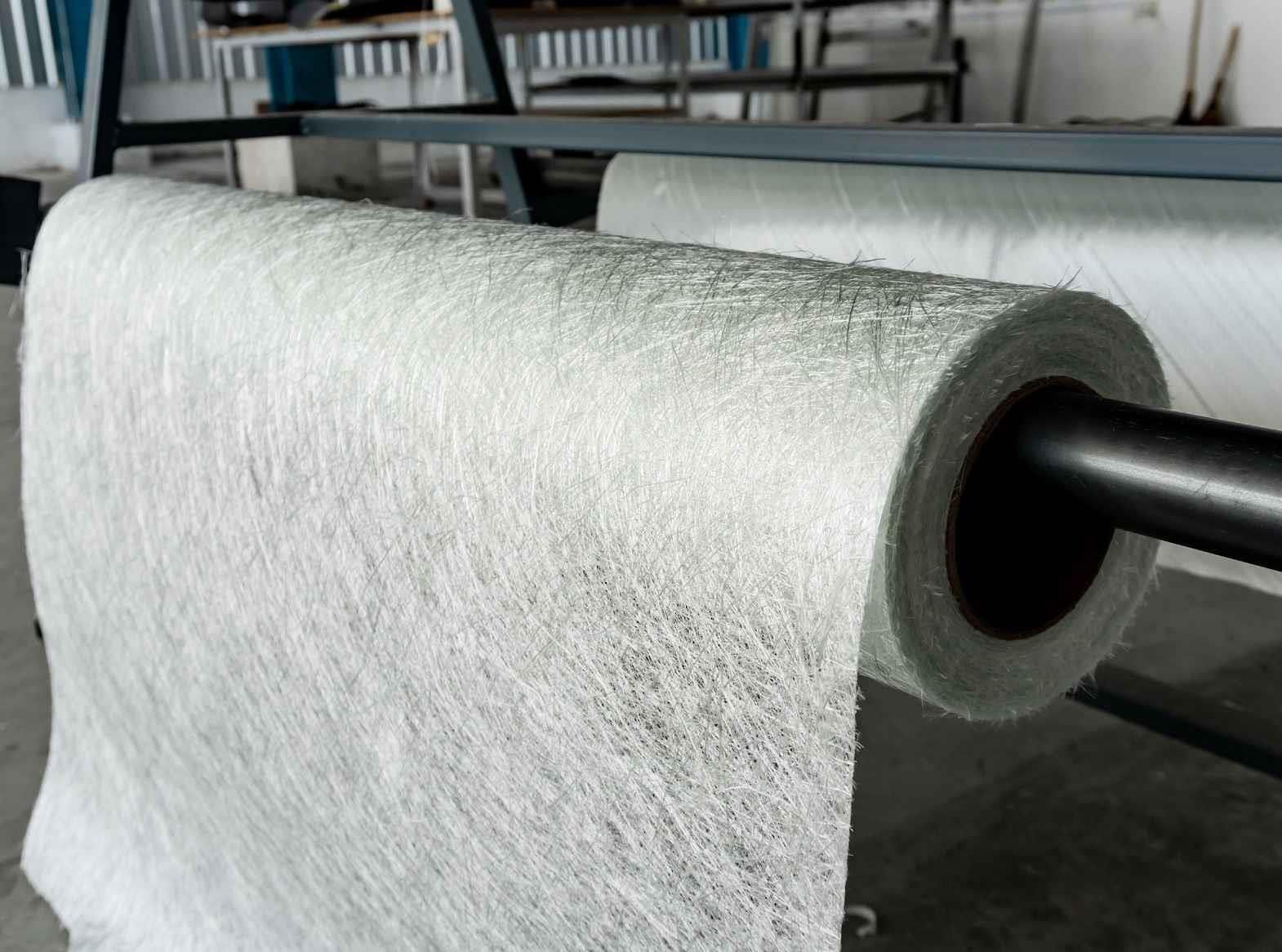Glass fibre is among the most versatile industrial materials available today. It can be readily produced from raw materials that are available in almost limitless quantities. This material is produced by extruding tiny strands from silica-based or other glass formulations into numerous fibres with very small diameters. Its mechanical properties are on par with those of other fibres, such as carbon fibre and polymers.
Glass fibres are valued for their exceptional damage tolerance to impact stresses, high specific strength, and stiffness, making them particularly useful in the marine and piping industries. Glass fibres are used in the manufacture of printed circuit boards, structural composites, and various specialty products. The potential adoption of high-volume glass reinforcement for metal body parts and components, as well as for a wide range of home and industrial equipment, could open up major new markets for the manufacturing industry.
History of Glass Fibre
The history of glass fibre dates back to times even before the technology of glass blowing was developed, when it was discovered that fine glass fibres could be produced. In ancient Egypt, a common method for creating cups involved winding glass fibres around a suitably shaped clay rim.
This technique was later utilised by Venetian glassmakers in the 16th and 17th centuries, following the introduction of glass in the first century BC. In one notable method, opaque white fibre bundles were twisted around the exterior of a transparent vessel, such as a goblet, and then heated to a high temperature. Similarly, in England, the glass industry produced decorative effects using this approach.
The textile industry took longer to recognise the potential of fibreglass. In 1713, French physicist Rene- Antoine Ferchault de Reaumur created textiles adorned with fine glass strands, hypothesising that if glass fibres could be drawn to the fineness of a spider’s web, they would be malleable enough for weaving. Remarkably, he managed to extract these fibres directly from molten glass, rather than from a glass rod.
In 1822, British inventors experimented with this concept. A British silk weaver invented glass fabric in 1842. Another weaver, Edward Liebey, showcased a glass dress at the 1893 Columbian Exposition in Chicago.1
In France, at the start of the 19th century, luxurious brocades were woven with deeply coloured silk and fibreglass, creating patterns of brilliant silver against dark backgrounds. In the 1890s, Edward Drummond Libby of Toledo, Ohio, produced garments from a fabric blending fibreglass and silk, as well as materials for ties and lampshades. Simultaneously, a small Parisian company produced textiles combining silk or cotton with glass fibres, selling for 100 francs per metre, demonstrating the potential for fibreglass production and use, even if it was unlikely to become a major market.
The method of creating glass fibres using a bushing was first demonstrated in 1908 by W. von Paczinsky in Hamburg. The 1930s saw the development in the United States of the process of drawing fibres through tiny holes to make textile glass fibres. A similar process began in Germany in 1939.
The initial requirement for large quantities of continuous fibre was for the electrical coupling of thin wires at high temperatures, necessitating the development of a new glass with suitable electrical properties that could be drawn into fibres. This led to the creation of ‘E-glass’, where ‘E’ stands for electrical insulation compatibility.
The first patents for thermosetting resins, such as polyesters, applied at room temperature emerged in 1935. These resins, when reinforced with fibreglass, could be used to create structural shapes, significantly benefiting the plastics industry. A notable early application was in World War II, with the production of radomes for airplanes.
Since then, the industry has expanded at a rate of 10 to 15 per cent per year, with rapid advances in productivity and technology. The applications of glass fibre have broadened significantly, including the construction of large vessels to utilise the non-magnetic properties of reinforced plastics, the strengthening of thermoplastics for use in automobiles, and the sophisticated engineering applications of combining glass with other fibres.
Manufacturing Process
The process of manufacturing glass fibre, although refined over time, still closely follows the methodology developed in the 1930s, albeit on a much larger scale. Modern techniques incorporate rapid heating and cooling, among other steps, to produce the fibres. This process comprises five main stages:
Batching: Commercial glass fibre can technically be produced from silica alone, but additional ingredients are added to lower the working temperature and bestow properties useful for specific applications. For example, E-glass, designed as a more alkali-resistant alternative to traditional soda-lime glass for electrical applications, includes silica (SiO2), aluminium oxide (Al2O3), calcium oxide (CaO), and magnesium oxide (MgO) in its composition. Boron oxide (B2O3) was later introduced to prevent nozzle clogging during fibre production, by increasing the temperature difference between melting and the formation of crystalline structures. The first step in glass manufacture involves precise weighing and thorough mixing of these ingredients, now automated with enclosed material transport systems and computerised devices. For instance, at Owens Corning’s plant in Taloja, India, ingredients are pneumatically conveyed to designated silos, where an automated system ensures precise mixing.
Melting: The mixed batch is transported to a high-temperature (about 1400oC/2552oF) natural gas-fired furnace for melting. The furnace is divided into sections to manage the glass flow and improve homogeneity, including bubble removal. The glass moves from the melting zone to the refiner, where the temperature is slightly reduced, and then to the forehearth, positioned above bushings used for extruding the molten glass into fibres.
Fibre Spinning: This stage involves extruding the molten glass through bushings containing up to 8,000 tiny orifices made from an erosion-resistant platinum/rhodium alloy, a process known as fibre spinning, or more specifically, the bushing process. The bushing plates are electrically heated to maintain consistent glass viscosity. As the filaments emerge at approximately 1204oC/2200oF, they are cooled by water jets.
Coating: The filaments are then coated with a chemical layer or size, which includes lubricants to prevent scratching and breaking as the filaments are gathered into forming packages and subsequently processed into textiles or other forms. Coupling agents in the size enhance the bond between the fibre and resin matrix, catering to specific resin chemistries.
Drying/Packaging: The sized filaments are wound into strands, containing between 51 to 1,624 threads, and formed into bundles on a drum, resembling a spool of thread. These bundles, having been moistened during cooling and sizing, are dried in an oven and then prepared for shipping or further processing into yarn, roving, or chopped fibre.
Use in Technical Textiles
Glass fibre is utilised in technical textiles for several compelling reasons:
Abundant Raw Materials: Glass fabrics are made from silica, a material that is plentiful in nature. This avoids the need for extracting non-renewable resources or cultivating crops, making it a more environmentally friendly choice due to its reduced impact on resource depletion and land use.
Durability and Longevity: The exceptional durability and resilience of glass fabric make it a sustainable option. It outlasts many traditional textiles, thanks to its resistance to chemicals, heat, and UV radiation, leading to reduced waste and the need for less frequent replacements.
Energy-Efficient Production: Producing this material involves melting silica and extruding it into fibres, which are then woven into fabric. Although melting requires energy, the overall production process consumes less energy compared to other textile fibres. Technological advancements have further enhanced the energy efficiency of its production.
Recyclability: Glass fabric is highly recyclable, able to be reprocessed into new materials at the end of its lifecycle without losing its original properties. This reduces waste and reliance on virgin resources, contributing to its environmental sustainability.
Versatility and Performance: Its unique properties make it suitable for a wide range of applications, from heat curtains and upholstery to specialised fabrics for firefighting equipment and composites. This versatility allows textile producers to offer a broader product range and tap into new markets.
Increased Consumer Demand: As consumer awareness and demand for eco-friendly textile products grow, glass fabric appeals to those prioritising sustainability. This can lead to market expansion and new business opportunities for manufacturers, driven by the willingness of consumers to invest in high-quality, sustainable products.
Cost-Effective Production: Over the long term, producing this material can be economically advantageous. While the initial investment in machinery may be higher than for traditional textiles, the longevity of the equipment compensates for this, leading to savings through reduced replacements and maintenance. Additionally, its heat-resistant properties may negate the need for further insulation or fireproofing, reducing overall costs.
Environmentally Friendly: The production process of this material minimally impacts the environment. Its inherent resistance to fire, chemicals, and UV radiation eliminates the need for harmful chemical treatments. Its use in industries such as automotive, aerospace, and construction reduces energy consumption and greenhouse gas emissions, thanks to its excellent thermal stability and resistance to degradation.
Is Glass Fibre a Sustainable Choice?
Glass fibre production involves the melting of silica sand, an abundant natural resource, along with other additives at high temperatures. Although glass fibre is recyclable and contributes to energy efficiency and durability across various applications, its overall sustainability hinges on multiple factors.
-
Energy Consumption: The production of glass fibre requires significant energy due to the high temperatures needed for melting processes, typically relying on fossil fuels. However, the impact can be lessened through advancements in energy-efficient technologies and the adoption of renewable energy sources.
-
Environmental Impact: The manufacture of glass fibre does not directly result in greenhouse gas emissions but can lead to air pollution and water contamination if manufacturing processes are not carefully managed. Reducing environmental impact necessitates efforts to minimise emissions and waste by enhancing manufacturing techniques and implementing effective waste management practices.
-
Recycling: Glass fibre is recyclable, allowing for the use of recycled glass in producing new fibres. Recycling helps reduce the demand for virgin materials and can decrease energy consumption and greenhouse gas emissions from production processes.
-
End-of-Life Considerations: The sustainability of glass fibre also depends on how products are disposed of at the end of their life cycle. Although glass fibre is inert and non-toxic, improper disposal in landfills can lead to waste buildup. Promoting recycling and exploring innovative ways to repurpose or reuse glass fibre products are crucial steps in addressing this challenge.
Therefore, glass fibre can be considered a sustainable choice only when its production and end-of-life processes are managed with environmental considerations in mind.
Some Recent Trends in Glass Fibre
In recent years, several innovative trends in glass fibres are shaping industries, offering new functionalities, and enhancing performance across various applications.
Fibreglass: Known for its stability against temperature variations and sunlight, fibreglass maintains a modern appearance and durability. It is used to reinforce polymers in multiple sectors, including construction, civil engineering, automotive, marine, sporting goods, and aerospace. With its remarkable strength, lightweight, and flexibility, fibreglass is an excellent material for creating a wide array of intricate shapes, finding extensive use in products such as bathtubs, yachts, airplanes, and roofing.
Smart Glass: Transforming static materials into dynamic solutions, smart glass introduces versatility in controlling visible, UV, and infrared light. The technology behind smart privacy glass allows transparent materials, like glass or polycarbonate, to shift from clear to shaded or fully opaque on demand. This innovation finds applications in various sectors, including consumer electronics, architecture, retail displays, interior design, and automotive, for windows, partitions, and other transparent surfaces.
Glass Fibre Composites: As a type of fibre-reinforced polymer composite, glass fibre composite (GFC) is celebrated for its low density, high strength, and processing ease. These attributes make it a favourite in construction, automotive, and aerospace industries. The composites are sought after for their combination of lightweight, robustness, and ease of fabrication.
Silicone Coated Glass Cloth: This material features glass fabric coated with silicone rubber on both sides, chosen for its exceptional resistance to ageing, weathering, and UV light. Its applications benefit from silicone’s heat resistance, water repellency, and flame and smoke retardancy. Flexible and durable, silicone-coated glass cloth is used in insulation jackets and various fabrications for it being water and oil resistant, emitting minimal smoke, non-halogenic, flame retardant, and withstanding temperatures up to 250oC.
Glass Fabrics Market Regional Analysis
The glass fabrics market is experiencing significant growth, driven by various factors across different regions, including North America, Asia-Pacific (APAC), Europe, the United States, and China.
North America: The aerospace industry’s extensive use of glass fabrics for producing lightweight, high-performance aircraft components is a major driver in North America. Additionally, the automotive industry, especially in the US, is increasing demand for glass fabrics to enhance the durability and safety of vehicles.
As a key player in the global market, the United States boasts a substantial demand for glass fabrics across automotive, construction, marine, and aerospace industries. The country’s pursuit of high-performance materials and strict safety regulations are key factors driving the demand for glass fabrics.
APAC Region: Rapid industrialisation and urbanisation in the APAC region are boosting the glass fabrics market. Countries like China, India, and Japan are witnessing substantial infrastructural developments, escalating the use of glass fabrics in the construction sector. Moreover, the growing wind energy sector in Asia- Pacific is propelling the demand for glass fabrics for turbine blades.
As the world’s largest industrial hub, China presents a growing market for glass fabrics. Ongoing urbanisation and industrialisation efforts are increasing the demand for glass fabrics in infrastructure and construction projects. Additionally, the country’s burgeoning wind energy sector and expanding automotive industry are contributing to market expansion.
Europe: The market in Europe is significantly influenced by the thriving automotive and aerospace industries. The demand for glass fabrics is rising due to stringent safety standards and the need for lightweight materials.
The region’s well-established textile industry also supports market growth by providing innovative glass fabric products.
Future of Glass Fibre
Glass fibre is poised for significant growth, driven by rising demand in the construction and automotive industries. It is increasingly being utilised in creating lighter structures for automobiles and aircraft. Furthermore, glass and mixed composites are set to replace metal in various applications, including boats and shells for utility and recreational vehicles.
In construction, glass fibres are used as raw materials for roofing, cladding, insulation, and surface coatings. Their affordability and mechanical properties, comparable to other fibres such as carbon and polymers—including stiffness, flexibility, transparency, resistance to chemical degradation, and inertness—make them highly sought after.
Fibreglass: The global fibreglass market is projected to experience a Compound Annual Growth Rate (CAGR) exceeding 7.2 per cent by 20302. With the market size valued at approximately $28.0 billion in 2022, it is forecast to reach around $40.0 billion by 2030.
The fibreglass (also called glass fibre reinforcements) market currently offers a wide range of products that can be customised to meet specific requirements and user preferences. The industry’s rising popularity has fuelled market expansion, and further technological innovations and creative production methods for glass fibre are anticipated.
Two significant factors are expected to impact the fibreglass market: the post-COVID-19 pandemic and the Russia-Ukraine war. The ongoing conflict has caused political and economic instability, reducing consumer spending power in the region. Additionally, the pandemic has significantly disrupted supply chains, posing challenges for manufacturers in terms of production and distribution.
However, it is important to note that fibreglass and glass fibre reinforcements are considered essential components, and demand for these products is expected to rebound once stability is restored. Large manufacturers, capable of navigating prolonged periods of uncertainty, with diversified customer bases, adaptable production capabilities, and strong financial standings, are likely to emerge as key players in this scenario.
Ending Note
Glass fibres stand as a remarkably versatile class of materials. Since their commercialisation 80 years ago, the fundamental technology behind glass fibre has seen numerous enhancements, yet its core design has remained largely unchanged. Commonly, glass fibres are used as a reinforcing material for unsaturated polyester and epoxy, two types of polymeric resins. While glass fibre may not boast the same stiffness as some other reinforcing fibres, it uniquely offers low density, very high strength, and most importantly, an exceptionally cost-effective price point.
In essence, while glass fibre presents several advantages such as strength, durability, and recyclability, its sustainability hinges on various factors including energy consumption, environmental impact, the presence of recycling infrastructure, and the practices surrounding end-of-life management. Initiatives aimed at enhancing energy efficiency, minimising emissions, boosting recycling efforts, and encouraging responsible disposal practices are crucial for optimising the sustainability of glass fibre as a material choice. Looking ahead, glass fibre is set to remain an indispensable reinforcement material, continuing its legacy of innovation and utility.
- https://www.sciencedirect.com/topics/materials-science/glass-fiber
- https://www.zionmarketresearch.com/news/global-fiberglass-market








